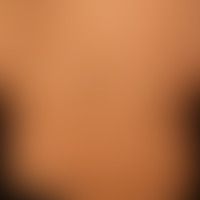
Psoriasis vulgaris L40.00
psoriasis vulgaris. treated psoriasis vulgaris. the previously existing typical psoriatic plaques are replaced by red spots with marginal hyperpigmentation. the treatment was carried out locally with dithranol [cignolin]. scaling no longer present. the brewing discoloration of the lesional surroundings are reversible discolorations of the nromal skin by diathranol. the diagnosis "psoriasis" is doubtless due to the known anamnesis.

Becker's nevus D22.5
Becker nevus: planar and spatter-like hyperpigmentation, focal hypertrichosis in the region of the lateral thoracic wall in young men; hardly visible at birth, postpubertal expression.

Atopic dermatitis in children and adolescents L20.8
eczema atopic in childhood: 14-year-old adolescent with generalized atopic eczema. striking grey-brown, dry skin. multiple scratched papules and plaques. extensive, therapy-resistant pyoderma on the left thigh (developed after traumatic abrasion)

Linea nigra L81.9
Linea fusca. sharply defined, linear, brown, smooth, non-pruritic hyperpigmentation in a 28-year-old pregnant woman in 24th week of pregnancy. the line runs from the symphysis pubica upwards to the epigastrium. the clinical picture is diagnostically conclusive.

Striae cutis distensae L90.6
Striae cutis distensae: Fresh (red), symmetrical striae after many years of internal and local (steroid inhalation) therapy with glucocorticoids for bronchial asthma.

Amyloidosis macular cutaneous E85.4
Amyloidosis macular cutaneous: Apparently UV-intensified brown-black spot and plaque formation in the breast area. unexposed areas less affected.

Graft-versus-host disease chronic L99.2-
generalized cGVHD: generalized, scleroderma-like, hardly itchy generalized skin disease. graft-versus-host disease occurred about 2 years after stem cell transplantation. poikiloderma with bunchy, hyper- and depigmented indurated plaques.

Maculopapular cutaneous mastocytosis Q82.2
Urticaria pigmentosa: general view: about 0.5-1.0cm large, disseminated, oval or round, brownish-red spots. only when rubbed, increased redness of the spots with accompanying itching. also in warm showers or baths increased redness and clearly palpable elevation of the lesions.

Addison's disease E27.1
Addison's disease: homogeneous hyperpigmentation of the back in a 35-year-old man; especially accentuated on the lateral parts of the back and in the lumbar region. The patient made a statement typical for Addison's disease: "Last summer's suntan did not recede as usual" The transverse light stripes of the lumbar region correspond in appearance to striae cutis distensae.

Dermatitis contact allergic L23.0
Dermatitis contact allergic: extensive itching, blurredly limited erythema.

Asymmetrical nevus flammeus Q82.5
Vascular twin nevus: Combination of a nevus flammeus with a nevus anaemicus.

Lentigo maligna D03.-
Lentigo maligna: a slow-growing, completely symptom-free spot that has been known for years; histologically, no invasiveness (transition to lentigo maligna melanoma) could be detected even in cut series.

Maculopapular cutaneous mastocytosis Q82.2
Urticaria pigmentosa (overview): Adult form of Urticaira pigmentosa (erythroderma), with a history of many years, continuous increase in the density of spots, course over 7 years.











